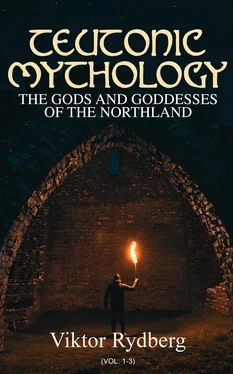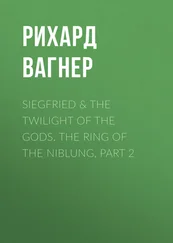Viktor Rydberg - Teutonic Mythology - The Gods and Goddesses of the Northland (Vol. 1-3)
Здесь есть возможность читать онлайн «Viktor Rydberg - Teutonic Mythology - The Gods and Goddesses of the Northland (Vol. 1-3)» — ознакомительный отрывок электронной книги совершенно бесплатно, а после прочтения отрывка купить полную версию. В некоторых случаях можно слушать аудио, скачать через торрент в формате fb2 и присутствует краткое содержание. Жанр: unrecognised, на английском языке. Описание произведения, (предисловие) а так же отзывы посетителей доступны на портале библиотеки ЛибКат.
- Название:Teutonic Mythology: The Gods and Goddesses of the Northland (Vol. 1-3)
- Автор:
- Жанр:
- Год:неизвестен
- ISBN:нет данных
- Рейтинг книги:4 / 5. Голосов: 1
-
Избранное:Добавить в избранное
- Отзывы:
-
Ваша оценка:
- 80
- 1
- 2
- 3
- 4
- 5
Teutonic Mythology: The Gods and Goddesses of the Northland (Vol. 1-3): краткое содержание, описание и аннотация
Предлагаем к чтению аннотацию, описание, краткое содержание или предисловие (зависит от того, что написал сам автор книги «Teutonic Mythology: The Gods and Goddesses of the Northland (Vol. 1-3)»). Если вы не нашли необходимую информацию о книге — напишите в комментариях, мы постараемся отыскать её.
One of Rydberg's mythological theories developed in this book is that of a vast World Mill which rotates the heavens, which he believed was an integral part of Old Norse mythic cosmology.
Teutonic Mythology: The Gods and Goddesses of the Northland (Vol. 1-3) — читать онлайн ознакомительный отрывок
Ниже представлен текст книги, разбитый по страницам. Система сохранения места последней прочитанной страницы, позволяет с удобством читать онлайн бесплатно книгу «Teutonic Mythology: The Gods and Goddesses of the Northland (Vol. 1-3)», без необходимости каждый раз заново искать на чём Вы остановились. Поставьте закладку, и сможете в любой момент перейти на страницу, на которой закончили чтение.
Интервал:
Закладка:
From England this same distortion of the myth comes to the North in connection with the hypothesis concerning the immigration of the "Asiamen," and is there finally accepted in the most unconcerned manner, without the least regard to the mythic records which were still well known. Skjold, Scef's son, is without any hesitation changed into a son of Odin (Ynglingasaga, 5; Foreword to Gylfag., 11). Yngve, who as the progenitor of the Ynglings is identical with Scef, and whose very name, perhaps, is or has been conceived as an epithet indicating Scef's tender age when he came to the coast of Scandia—Yngve-Scef is confounded with Frey, is styled Yngve-Frey after the appellation of the Vana-god Ingunar Frey, and he, too, is called a son of Odin (Foreword to Gylfag., c. 13), although Frey in the myth is a son of Njord and belongs to another race of gods than Odin. The epithet with which Are Frode in his Schedæ characterises Yngve, viz., Tyrkiakonungr , Trojan king, proves that the lad who came with the sheaf of grain to Skane is already in Are changed into a Trojan.
21.
SCEF THE AUTHOR OF CULTURE IDENTICAL WITH HEIMDAL-RIG, THE ORIGINAL PATRIARCH.
Table of Contents
But in one respect Are Frode or his authority has paid attention to the genuine mythic tradition, and that is by making the Vana-gods the kinsmen of the descendants of Yngve. This is correct in the sense that Scef-Yngve, the son of a deity transformed into a man, was in the myth a Vana-god. Accordingly every member of the Yngling race and every descendant of Scef may be styled a son of Frey ( Freys áttungr ), epithets applied by Thjodulf in Ynglingatal in regard to the Upsala kings. They are gifts from the Vana-gods—the implements which point to the opulent Njord, and the grain sheaf which is Frey's symbol—which Scef-Yngve brings with him to the ancient people of Scandia, and his rule is peaceful and rich in blessings.
Scef-Yngve comes across the ocean. Vanaheim was thought to be situated on the other side of it, in the same direction as Ægir's palace in the great western ocean and in the outermost domain of Jormumgrund (see 93). This is indicated in Lokasenna, 34, where Loke in Ægir's hall says to the Van Njord: "You were sent from here to the East as a hostage to the gods ( thu vart austr hedan gisl um sendr at godum )". Thus Njord's castle Noatun is situated in the West, on a strand outside of which the swans sing (Gylfag., 23). In the faded memory of Scef, preserved in the saga of the Lower Rhine and of the Netherlands, there comes to a poverty-stricken people a boat in which there lies a sleeping youth. The boat is, like Scef's, without sails or oars, but is drawn over the billows by a swan. From Gylfaginning, 16, we learn that there are myths telling of the origin of the swans. They are all descended from that pair of swans which swim in the sacred waters of Urd's fountain. Thus the descendants of these swans that sing outside of the Vanapalace Noatun and their arrival to the shores of Midgard seems to have some connection with the coming of the Van Scef and of culture.
The Vans most prominent in the myths are Njord, Frey, and Heimdal. Though an Asa-god by adoption, Heimdal is like Njord and Frey a Vana-god by birth and birthplace, and is accordingly called both áss and vanr (Thrymskv., 15). Meanwhile these three divinities, definitely named Vans, are only a few out of many. The Vans have constituted a numerous clan, strong enough to wage a victorious war against the Asas (Völusp.). Who among them was Scef-Yngve? The question can be answered as follows:
(1) Of Heimdal, and of him alone among the gods, it is related that he lived for a time among men as a man, and that he performed that which is attributed to Scef—that is, organised and elevated human society and became the progenitor of sacred families in Midgard.
(2) Rigsthula relates that the god Heimdal, having assumed the name Rig, begot with an earthly woman the son Jarl-Rig, who in turn became the father of Konr-Rig. Konr-Rig is, as the very name indicates and as Vigfusson already has pointed out, the first who bore the kingly name. In Rigsthula the Jarl begets the king, as in Ynglingasaga the judge (Dómarr) begets the first king. Rig is, according to Ynglingasaga, ch. 20, grandfather to Dan, who is a Skjoldung. Heimdal-Rig is thus the father of the progenitor of the Skjoldungs, and it is the story of the divine origin of the Skjoldungs Rigsthula gives us when it sings of Heimdal as Jarl's father and the first king's grandfather. But the progenitor of the Skjoldungs is, according to both Anglo-Saxon and the northern sources above quoted, Scef. Thus Heimdal and Scef are identical.
These proofs are sufficient. More can be presented, and the identity will be established by the whole investigation.
As a tender boy, Heimdal was sent by the Vans to the southern shores of Scandinavia with the gifts of culture. Hyndla's lay tells how these friendly powers prepared the child for its important mission, after it was born in the outermost borders of the earth ( vid jardar thraum ), in a wonderful manner, by nine sisters (Hyndla's Lay, 35; Heimdallar Galdr., in the Younger Edda; compare No. 82, where the ancient Aryan root of the myth concerning Heimdal's nine mothers is pointed out).
For its mission the child had to be equipped with strength, endurance, and wisdom. It was given to drink jardar magn svalkaldr sær and Sonar dreyri . It is necessary to compare these expressions with Urdar magn , svalkaldr sær and Sónar dreyri in Gudrunarkivda, ii. 21, a song written in Christian times, where this reminiscence of a triple heathen-mythic drink reappears as a potion of forgetfulness allaying sorrow. The expression Sónar dreyri shows that the child had tasted liquids from the subterranean fountains which water Yggdrasil and sustain the spiritual and physical life of the universe (cp. Nos. 63 and 93). Són contains the mead of inspiration and wisdom. In Gylfaginning, which quotes a satire of late origin, this name is given to a jar in which Suttung preserves this valuable liquor, but to the heathen skalds Són is the name of Mimer's fountain, which contains the highest spiritual gifts, and around whose rush-bordered edge the reeds of poetry grow (Eilif Gudrunson, Skáldskaparmál). The child Heimdal has, therefore, drunk from Mimer's fountain. Jardar magn (the earth's strength) is in reality the same as Urdar magn , the strength of the water in Urd's fountain, which keeps the world-tree ever green and sustains the physical life of creation (Völusp.). The third subterranean fountain is Hvergelmer, with hardening liquids. From Hvergelmer comes the river Sval, and the venom-cold Elivogs (Grimner's Lay, Gylfaginning). Svalkaldar sær , cool sea, is an appropriate designation of this fountain.
When the child has been strengthened in this manner for its great mission, it is laid sleeping in the decorated ship, gets the grain-sheaf for its pillow, and numerous treasures are placed around it. It is certain that there were not only weapons and ornaments, but also workmen's tools among the treasures. It should be borne in mind that the gods made on the plains of Ida not only ornaments, but also tools ( tangir skópu ok tol gördu ). Evidence is presented in No. 82 that Scef-Heimdal brought the fire-auger to primeval man who until that time had lived without the blessings produced by the sacred fire.
The boy grows up among the inhabitants on the Scandian coast, and, when he has developed into manhood, human culture has germinated under his influence and the beginnings of classes in society with distinct callings appear. In Rigsthula, we find him journeying along "green paths, from house to house, in that land which his presence has blessed." Here he is called Rigr —it is true of him as of nearly all mythological persons, that he has several names—but the introduction to the poem informs us that the person so called is the god Heimdal ( einhverr af asum sá er Heimdallr het ). The country is here also described as situated near the sea. Heimdal journeys framm med sjofarströndu . Culture is in complete operation. The people are settled, they spin and weave, perform handiwork, and are smiths, they plough and bake, and Heimdal has instructed them in runes. Different homes show different customs and various degrees of wealth, but happiness prevails everywhere. Heimdal visits Ai's and Edda's unpretentious home, is hospitably received, and remains three days. Nine months thereafter the son Träl (thrall) is born to this family. Heimdal then visits Ave's and Amma's well-kept and cleanly house, and nine months thereafter the son Karl (churl) is born in this household. Thence Rig betakes himself to Fadir's and Modir's elegant home. There is born, nine months later, the son Jarl. Thus the three Teutonic classes—the thralls, the freemen, and the nobility—have received their divine sanction from Heimdal-Rig, and all three have been honoured with divine birth.
Читать дальшеИнтервал:
Закладка:
Похожие книги на «Teutonic Mythology: The Gods and Goddesses of the Northland (Vol. 1-3)»
Представляем Вашему вниманию похожие книги на «Teutonic Mythology: The Gods and Goddesses of the Northland (Vol. 1-3)» списком для выбора. Мы отобрали схожую по названию и смыслу литературу в надежде предоставить читателям больше вариантов отыскать новые, интересные, ещё непрочитанные произведения.
Обсуждение, отзывы о книге «Teutonic Mythology: The Gods and Goddesses of the Northland (Vol. 1-3)» и просто собственные мнения читателей. Оставьте ваши комментарии, напишите, что Вы думаете о произведении, его смысле или главных героях. Укажите что конкретно понравилось, а что нет, и почему Вы так считаете.











